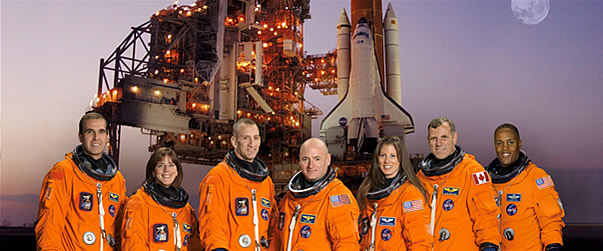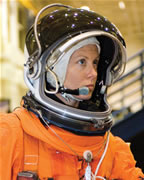Congratulations and Welcome Home
Tracy Caldwell (’93) Returns from Successful Shuttle Mission
August 22, 2007
“Congratulations. Welcome home.”
Those first words from NASA’s mission control greeted the crew of the space shuttle, Endeavour, as it made a perfect landing yesterday at Cape Canaveral. Tracy Caldwell, a Cal State Fullerton alumna, served as a mission specialist for the flight.
After nearly two weeks in space, the crew completed four spacewalks. Caldwell’s many duties included operating the robotic arm that assisted her fellow astronauts during their spacewalks.
Endeavour flight STS-118 was charged with transporting and installing part of the support framework on the space station the Spacehab pressurized carrier and an external stowage platform. Caldwell is a mission specialist for the voyage, her maiden space flight.
Caldwell, who was selected as an astronaut in 1998, received her bachelor’s degree in chemistry in 1993 and calls her education at Cal State Fullerton her launching pad. In particular, Caldwell cites John Olmsted and Scott Hewitt, her chemistry and biochemistry professors, as two major influences when she was a student.
Olmsted, Caldwell said, constantly encouraged her, telling her that she could be whatever she wanted to be, just as her father had done. When she graduated, she gave Olmstead a photo of the two of them affixed to a small model of a shuttle. When she returned to the campus six years later — as an astronaut — Olmsted still had it on his desk.
Caldwell recalled one incident in particular with Hewitt: The last day she spent in his lab, she stayed late. Hewitt directed her to a particular spot in the room that had equipment racks with many blinking lights. Then, he turned off the lights.
“What do you think?” he asked her. Caldwell wasn’t sure what he meant.
“Doesn’t it look like the cockpit of a space shuttle?” he asked.
Years later, Caldwell recalled that moment: “That was just like him. Always rooting for me.”
Hewitt remembers, too, but from a different perspective.
“She had helped build this complex piece of equipment,” he said, referring to a laser-ionization time-of-flight mass spectrometer used for studying atmospherically relevant gas-phase chemistry. But, it needed an electronic safeguard so it could automatically shut down before overloading. Caldwell helped Hewitt design and build the device in 1993 before she left for graduate school at UC Davis, where she earned her doctorate in physical chemistry in 1997.
“It was her last night before she had to go,” Hewitt recalled. “She hadn’t even packed yet and it was maybe 10 o’clock at night. The device was installed but hadn’t actually functioned yet…. She was leaving, heading out for the next phase in her education and career, but she wanted to leave that project behind in perfect working condition. I was so impressed. One hour after she left the lab for the last time, it started working just as she’d designed it.”


